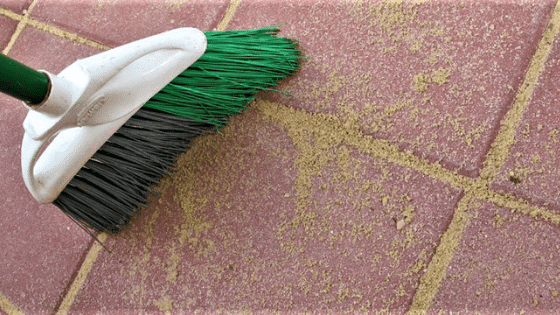Last Updated on January 24, 2023 by John Patterson
To keep sand between pavers for a long, you must use polymeric sand instead of regular sand.
Moreover, sealing the paver surface helps to last the joint sand even longer.
Why should you use polymeric sand as the paving sand instead of regular sand?
It’s because the regular sands don’t provide the required bond in the middle of the paver joints, and it can easily be washed away after heavy rainfall. Regular sands can’t prevent weed and moss growth too.
Applying the sand is not an uphill task by any means.
Bear with me as I’m going to tell you the steps involved in keeping the sand between the pavers in a moment.
Here is the list of items you should collect before you start applying polymeric sand between the pavers.
Once you gather the above tools, follow these steps –
Table of Contents
How Do You Keep Sand Between Pavers? Step-by-Step Guide
Step 1: First, check the weather to see if it’s suitable for installing polymeric sand.
It must be sunny when you plan to apply sand on the paver. At least after two days of using the sand on the paver surface, there shouldn’t be any rain.
You should choose a sunny day because you require a dry surface to apply the sand. It’s because you don’t want the sand to activate after pouring it on the ground. If the surface is wet beforehand, it will activate the sand right after you apply it to the surface.
Step 2: Choosing a high-quality polymeric sandbag is crucial, even if it costs more than expected. I recommend using Dominator Sand as it shines in quality and provides excellent value for the money.
Step 3: Dry clean the surface to remove any excess dust, pebbles, leaf, etc.
Step 4: Now, it’s time to pour the sand between the paver joints. Open the sandbag (preferably with a knife) and pour some sand on the surface.
Step 5: Next, use the broom to sweep the sand all over the surface gently.
The goal is to fill the brick joints appropriately with sand. There shouldn’t be any joints left unfilled with sand.
Step 6: Filling up the air pocket is vital in installing polymeric sand, and many people tend to skip this step, but you shouldn’t. Moreover, polymeric sand gives the best result when used in full depth.
Use a quality plate compactor (I recommend WEN 56035T) to run over the surface and let it help put the sand down. It will eventually fill up the air pocket efficiently.
Experts suggest running the compactor over the surface entirely at least twice to get the best results.
Step 7: Then, remove any remaining sand from the surface watchfully. You can use the same push broom or a leaf blower to blow off the remaining sand from the surface.
It’s essential to clean off the excess sand before applying water. Otherwise, those parts of the sand will stick to the surface and create a haze.
Step 8: Now, it’s time to activate the polymeric sand to create a powerful attachment between the paver joints.
The polymers inside the sand get activated when it comes in contact with water. That eventually creates a strong bond between the joints.
To do the dampening properly, it’s crucial to use a water hose with a misting nozzle so that it doesn’t wash away the sand before it gets activated.
Avoiding overwatering is essential here.
Repeat this step, number 8, at least three times. Take a 15-20 minute break in between the attempts.
Step 9: You are done with putting the sand between the pavers. Dampening the surface has already activated the polymers inside the sand.
Now, you must let it dry for at least one day before allowing foot traffic and at least two days before allowing vehicle traffic.
Sealing the Paving Surface
Following the above nine steps will let you keep sand between pavers.
On top of that, sealing the paving surface will secure the joint sands even more and protect it from washing out after heavy rainfall or using a power washer.
The sealers also help to make the joint even stronger. That means it works both as a protector and a bond enhancer.
I recommend using Masonry Defender Paver Sealer to get the job done efficiently.
Frequently Asked Questions (FAQs)
Question #1. What kind of sand do you use between pavers?
Answer: Back in the ’90s, people used basic silica sands between the paver stones.
Using regular sands or silica sands wasn’t a bad idea. However, those were not the best in terms of longevity. A rainstorm could easily let them wash away in no time.
Nowadays, polymeric sand is used between pavers to make a strong bond between the joints.
Polymeric sand is made of polymers that get activated once it comes in contact with water. It makes such a strong bond that heavy rainfall or water flow from pressure washers can’t damage the joints.
It doesn’t hurt the pocket to afford a bag of polymeric sand either.
Question #2. Should you put sand between pavers?
Answer: Yes, putting the sand between pavers is an excellent idea to make a bond between the pavers and secure the blocks and prevent movement.
With that said, don’t use regular sands between blocks as it doesn’t provide a strong bond between the blocks. On top of that, weed and moss tend to grow between the blocks if you use regular sand.
The solution is to use polymeric sand as the paving sand to get a strong bond and prevent weed growth.
Question #3. How do you finish pavers with sand?
Answer: In short, you have to pour the sand evenly throughout the surface. Then using the push broom, sweep the sand between the joints.
Next, run a plate compactor over the surface to fill up the air pockets.
Then use a leaf blower to clean off the remaining sands.
Finally, use a water hose to apply water on the surface to activate the polymers inside the sand and let it dry for at least 48 hours.
Final Words
This is how you keep the sand between pavers and secure a strong and durable bond.
No matter what, you must not go for cheap polymeric sand as it won’t last long and force you to spend more money in the future.
More How to Guides
#1. How to winterize a pressure washer: Step-by-step guide.
#2. How to charge a cordless drill battery without a charger.
#3. How to use a cordless drill: Step-by-step guide.






Can I use py.etric sand on mesh to put my pavers down and make them level?